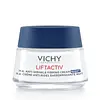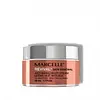What's inside
What's inside
 Key Ingredients
Key Ingredients

 Benefits
Benefits

 Concerns
Concerns

 Ingredients Side-by-side
Ingredients Side-by-side

Water
Skin ConditioningGlycerin
HumectantRhamnose
HumectantPrunus Armeniaca Kernel Oil
MaskingCaprylic/Capric Triglyceride
MaskingPentaerythrityl Tetraethylhexanoate
EmollientCetyl Alcohol
EmollientZea Mays Starch
AbsorbentButyrospermum Parkii Butter
Skin ConditioningPetrolatum
EmollientGlyceryl Stearate
EmollientPentylene Glycol
Skin ConditioningDimethicone
EmollientPEG-40 Stearate
EmulsifyingCera Alba
EmollientHydroxyethylpiperazine Ethane Sulfonic Acid
BufferingAdenosine
Skin ConditioningPentaerythrityl Tetra-Di-T-Butyl Hydroxyhydrocinnamate
AntioxidantSodium Hyaluronate
HumectantTriethanolamine
BufferingAscorbyl Glucoside
AntioxidantMagnesium Ascorbyl Phosphate
AntioxidantCaprylyl Glycol
EmollientCitric Acid
BufferingPoloxamer 338
EmulsifyingSorbitan Tristearate
EmulsifyingXanthan Gum
EmulsifyingDimethiconol
EmollientPhenoxyethanol
PreservativeParfum
MaskingWater, Glycerin, Rhamnose, Prunus Armeniaca Kernel Oil, Caprylic/Capric Triglyceride, Pentaerythrityl Tetraethylhexanoate, Cetyl Alcohol, Zea Mays Starch, Butyrospermum Parkii Butter, Petrolatum, Glyceryl Stearate, Pentylene Glycol, Dimethicone, PEG-40 Stearate, Cera Alba, Hydroxyethylpiperazine Ethane Sulfonic Acid, Adenosine, Pentaerythrityl Tetra-Di-T-Butyl Hydroxyhydrocinnamate, Sodium Hyaluronate, Triethanolamine, Ascorbyl Glucoside, Magnesium Ascorbyl Phosphate, Caprylyl Glycol, Citric Acid, Poloxamer 338, Sorbitan Tristearate, Xanthan Gum, Dimethiconol, Phenoxyethanol, Parfum
Water
Skin ConditioningOctyldodecanol
EmollientGlycerin
HumectantCocoglycerides
EmollientButylene Glycol
HumectantDicaprylyl Carbonate
EmollientCetearyl Alcohol
EmollientGlyceryl Stearate
EmollientCichorium Intybus Root Extract
MaskingHelianthus Annuus Seed Extract
Skin ConditioningGlycine Soja Seed Extract
Skin ConditioningHydrolyzed Candida Saitoana Extract
Skin ProtectingAcetyl Tetrapeptide-9
Skin ConditioningMannitol
HumectantLecithin
EmollientTocopherol
AntioxidantTocopheryl Acetate
AntioxidantRetinyl Palmitate
Skin ConditioningCetearyl Glucoside
EmulsifyingGlyceryl Oleate
EmollientAscorbyl Palmitate
AntioxidantHydroxyethylcellulose
Emulsion StabilisingArachidyl Propionate
EmollientEthyl Linoleate
EmollientEthyl Linolenate
EmollientEthyl Oleate
EmollientHydrogenated Coco-Glycerides
EmollientSodium Polyacrylate
AbsorbentAcetyl Dipeptide-1 Cetyl Ester
Skin ConditioningPentaerythrityl Distearate
EmulsifyingGlyceryl Oleate Citrate
EmulsifyingSodium Cocoyl Glutamate
CleansingSorbitan Laurate
EmulsifyingSodium Stearoyl Glutamate
CleansingSorbic Acid
PreservativePEG-100 Stearate
Dimethicone
EmollientDimethiconol
EmollientCaprylyl Glycol
EmollientPhenoxyethanol
PreservativeSodium Benzoate
MaskingEthylhexylglycerin
Skin ConditioningPotassium Sorbate
PreservativeSodium Chloride
MaskingWater, Octyldodecanol, Glycerin, Cocoglycerides, Butylene Glycol, Dicaprylyl Carbonate, Cetearyl Alcohol, Glyceryl Stearate, Cichorium Intybus Root Extract, Helianthus Annuus Seed Extract, Glycine Soja Seed Extract, Hydrolyzed Candida Saitoana Extract, Acetyl Tetrapeptide-9, Mannitol, Lecithin, Tocopherol, Tocopheryl Acetate, Retinyl Palmitate, Cetearyl Glucoside, Glyceryl Oleate, Ascorbyl Palmitate, Hydroxyethylcellulose, Arachidyl Propionate, Ethyl Linoleate, Ethyl Linolenate, Ethyl Oleate, Hydrogenated Coco-Glycerides, Sodium Polyacrylate, Acetyl Dipeptide-1 Cetyl Ester, Pentaerythrityl Distearate, Glyceryl Oleate Citrate, Sodium Cocoyl Glutamate, Sorbitan Laurate, Sodium Stearoyl Glutamate, Sorbic Acid, PEG-100 Stearate, Dimethicone, Dimethiconol, Caprylyl Glycol, Phenoxyethanol, Sodium Benzoate, Ethylhexylglycerin, Potassium Sorbate, Sodium Chloride
Ingredients Explained
These ingredients are found in both products.
Ingredients higher up in an ingredient list are typically present in a larger amount.
Caprylyl Glycol is a humectant and emollient, meaning it attracts and preserves moisture.
It is a common ingredient in many products, especially those designed to hydrate skin. The primary benefits are retaining moisture, skin softening, and promoting a healthy skin barrier.
Though Caprylyl Glycol is an alcohol derived from fatty acids, it is not the kind that can dry out skin.
This ingredient is also used as a preservative to extend the life of products. It has slight antimicrobial properties.
Learn more about Caprylyl GlycolDimethicone is a type of synthetic silicone created from natural materials such as quartz.
What it does:
Dimethicone comes in different viscosities:
Depending on the viscosity, dimethicone has different properties.
Ingredients lists don't always show which type is used, so we recommend reaching out to the brand if you have questions about the viscosity.
This ingredient is unlikely to cause irritation because it does not get absorbed into skin. However, people with silicone allergies should be careful about using this ingredient.
Note: Dimethicone may contribute to pilling. This is because it is not oil or water soluble, so pilling may occur when layered with products. When mixed with heavy oils in a formula, the outcome is also quite greasy.
Learn more about DimethiconeDimethiconol is a silicone that resembles the popular dimethicone. Like other silicones, it is an emollient. Emollients create a thin film on skin to prevent moisture from escaping.
This ingredient helps to create a silky texture and improve spreadability. Due to its high molecular weight and thickness, it is often combined with cyclopentasiloxane.
Glycerin is already naturally found in your skin. It helps moisturize and protect your skin.
A study from 2016 found glycerin to be more effective as a humectant than AHAs and hyaluronic acid.
As a humectant, it helps the skin stay hydrated by pulling moisture to your skin. The low molecular weight of glycerin allows it to pull moisture into the deeper layers of your skin.
Hydrated skin improves your skin barrier; Your skin barrier helps protect against irritants and bacteria.
Glycerin has also been found to have antimicrobial and antiviral properties. Due to these properties, glycerin is often used in wound and burn treatments.
In cosmetics, glycerin is usually derived from plants such as soybean or palm. However, it can also be sourced from animals, such as tallow or animal fat.
This ingredient is organic, colorless, odorless, and non-toxic.
Glycerin is the name for this ingredient in American English. British English uses Glycerol/Glycerine.
Learn more about GlycerinGlyceryl Stearate is a mix of glycerin and stearic acid.
It is used to stabilize the mixing of water and oil ingredients. By preventing these ingredients from separating, it can help elongate shelf life. It can also help thicken the product's texture.
As an emollient, it helps soften skin and supports barrier-replenishing ingredients.
In cosmetics, Glyceryl Stearate is often made from vegetable oils or synthetically produced.
This ingredient may not be fungal-acne safe
Fun fact: The human body also creates Glyceryl Stearate naturally.
Learn more about Glyceryl StearatePhenoxyethanol is a preservative that has germicide, antimicrobial, and aromatic properties. Studies show that phenoxyethanol can prevent microbial growth. By itself, it has a scent that is similar to that of a rose.
It's often used in formulations along with Caprylyl Glycol to preserve the shelf life of products.
Water. It's the most common cosmetic ingredient of all. You'll usually see it at the top of ingredient lists, meaning that it makes up the largest part of the product.
So why is it so popular? Water most often acts as a solvent - this means that it helps dissolve other ingredients into the formulation.
You'll also recognize water as that liquid we all need to stay alive. If you see this, drink a glass of water. Stay hydrated!
Learn more about Water